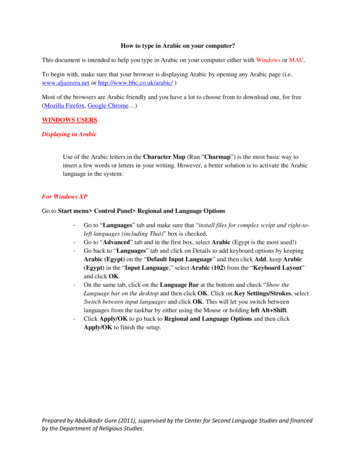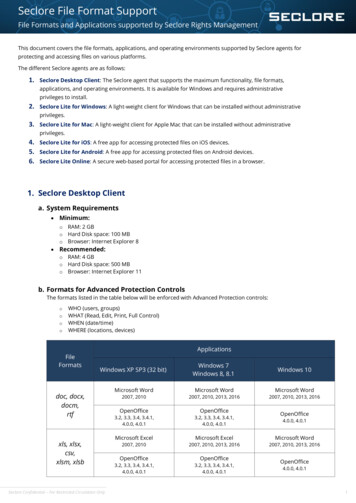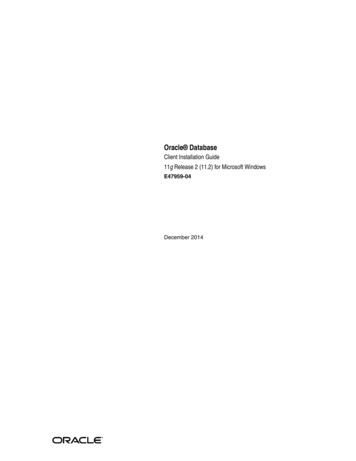
Transcription
How to type in Arabic on your computer?This document is intended to help you type in Arabic on your computer either with Windows or MAC.To begin with, make sure that your browser is displaying Arabic by opening any Arabic page (i.e.www.aljazeera.net or http://www.bbc.co.uk/arabic/ )Most of the browsers are Arabic friendly and you have a lot to choose from to download one, for free(Mozilla Firefox, Google Chrome )WINDOWS USERSDisplaying in ArabicUse of the Arabic letters in the Character Map (Run “Charmap”) is the most basic way toinsert a few words or letters in your writing. However, a better solution is to activate the Arabiclanguage in the system:For Windows XPGo to Start menu Control Panel Regional and Language Options---Go to “Languages” tab and make sure that “install files for complex script and right-toleft languages (including Thai)” box is checked.Go to “Advanced” tab and in the first box, select Arabic (Egypt is the most used!)Go back to “Languages” tab and click on Details to add keyboard options by keepingArabic (Egypt) on the “Default Input Language” and then click Add, keep Arabic(Egypt) in the “Input Language,” select Arabic (102) from the “Keyboard Layout”and click OK.On the same tab, click on the Language Bar at the bottom and check “Show theLanguage bar on the desktop and then click OK. Click on Key Settings/Strokes, selectSwitch between input languages and click OK. This will let you switch betweenlanguages from the taskbar by either using the Mouse or holding left Alt Shift.Click Apply/OK to go back to Regional and Language Options and then clickApply/OK to finish the setup.Prepared by Abdulkadir Gure (2011), supervised by the Center for Second Language Studies and financedby the Department of Religious Studies.
For Windows 7Go to Start menu Control Panel Clock, Language, and Region-Go to “Keyboards and Languages” and click on Change KeyboardsClick Add and from the list, click Arabic (Egypt is the most used!) and expand it.Click Keyboard under Arabic(Egypt).If Arabic 102 is not in the list, click Show More and select it from the list and thenclick OKClick Apply/OK to go back to Region and Language and then click Apply/OKPrepared by Abdulkadir Gure (2011), supervised by the Center for Second Language Studies and financedby the Department of Religious Studies.
MAC USERSFor Mac: Simply activate a “Keyboard layout” that will produce Arabic characters.-Go to System Preferences : International" (this is called Language and Textin the current 10.6 version) then click Input Menu ("Keyboard menu")Scroll down to Arabic and check the check box beside it.Go to Language, click Edit List then scroll down to Arabic and check it. Thenput Arabic language in your preferred first language.-You will now see a flag or keyboards menu on the menu bar. From there, you canchoose Arabic when needed.-If you don’t have Arabic keyboard, you can use the Keyboard Viewer by goingto Open International in the Flag/Keyboards menu and check “KeyboardViewer”Prepared by Abdulkadir Gure (2011), supervised by the Center for Second Language Studies and financedby the Department of Religious Studies.
ADDITIONAL NOTES--When typing in Arabic, you need to make sure that the cursor is starting from the right hand sideof the page by clicking the right justify button.It’s difficult to type in Arabic without an Arabic keyboard. You can either replace your Englishkeyboard with one that has both Arabic and English or you can get clear Arabic key top labels thatyou can stick on your keyboard to display both your regular characters and the additional Arabiccharacters. You have plenty of colors to choose from, be sure to get the right one! All are inwww.amazon.com or your store of choice.You will find that most of the Arabic keyboards we use have layout problems with mapping 48Arabic characters on the English 26-key keyboards; Letters with the same phonetic sounds ofArabic and Latin languages have been placed on different key locations which makes it difficultfor the typist to navigate easily. Intellark Keyboard Map addresses this problem by using theprevious knowledge of the typist on Latin-based keyboard layouts, alphabetical order of the Arabicletters, frequency order among Arabic letters of the same family, and hand-strokes of letters withina single block. If you are interested in the Intellark Keyboard Map, please look here:http://intellaren.com/intellarkRegular QWERTY keyboard with Arabic and English lettersIntellark Mapping on regular QWERTY keyboard with Arabic and English lettersPrepared by Abdulkadir Gure (2011), supervised by the Center for Second Language Studies and financedby the Department of Religious Studies.
Prepared by Abdulkadir Gure (2011), supervised by the Center for Second Language Studies and financedby the Department of Religious Studies.
- When typing in Arabic, you need to make sure that the cursor is starting from the right hand side of the page by clicking the right justify button. - It's difficult to type in Arabic without an Arabic keyboard. You can either replace your English keyboard with one that has both Arabic and English or you can get clear Arabic key top labels that











